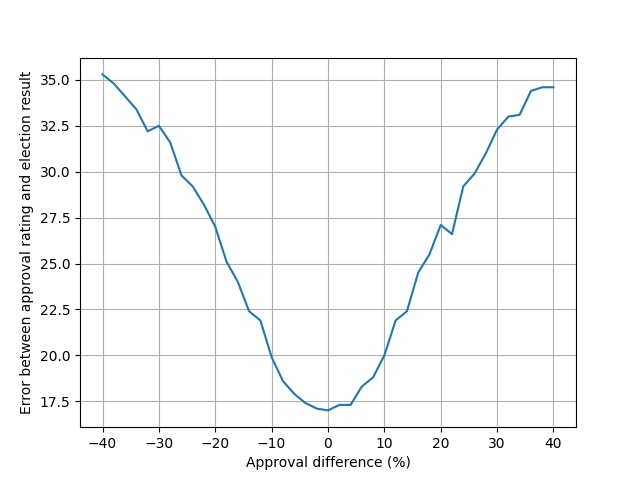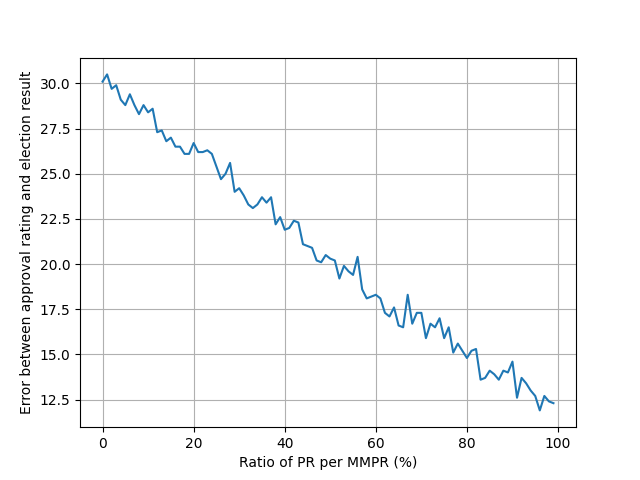Effect Analysis about Mixed Member Proportional System by Simulating
Date: 2022.09.01 ~ 2022.09.26
Writer: 9tailwolf
Caution:
- Every codes and images are made by
9tailwolf. For personal use only. - Every datas are made by Matplotlib in Python and Numbers.
Introduction
Summary
- Problem about gap between Vote rating-Election Results disrupt Democracy development.
- Mixed Member Proportional System1 will be expanded to solve gap between Vote rating-Election Result problem.
- Increasing the Proportional Representation2 ratio is also effective.
The principle of majority rule, which is known as the basic of democracy, has structural problems. In Korea, elections are usually conducted under the winner-takes-all principle based on the majority rule, which ultimately leads to unequal outcomes.3 Even a difference of 2%p in vote rating between a candidate who wins and a candidate who loses can result in the latter’s defeat. If this happens in all constituencies, a party with a 49% vote rating may not win any seats, while another party with a 51% vote rating can win all seats. Ideally, the number of seats should be determined by the percentage of votes (or support rate) received.
The following graph shows the gap between the vote rating and election outcomes based on the winner-takes-all principle. It assumes a difference in support for Party A and Party B between -40% and 40%, and represents the results of 10,000 simulations, including minor parties.”

South Korea is the first country in Asia to have achieved industrialization and the consolidation of democracy simultaneously. However, it has not yet reached complete democracy. The democracy in South Korea is still hindered by factors such as the bipartisan system and regionalism3. These factors lead to a phenomenon where only the opinions of the absolute majority with power are favored, and the opinions of the minority are suppressed. For the development of democracy in South Korea, each political party should work together to find common ground, and the phenomenon of being swayed by the absolute majority should be eliminated.
Currently, Korea has introduced a Proportional Representation2 system to solve this problem.
The Mixed-Member Proportional Representation3 system is a necessary system in our society that can break down the bipartisan system and regionalism more effectively.
Analysis of Proportional Representation Efficiency
I analyzed the relationship between PR and the gap between vote rating-election results. I conducted the analysis by increasing the proportional representation seats by one each for 300 times while setting a total of five support rate sets, with each set being tested 100 times. I assumed MMPR to be zero. (This simulation was conducted a total of 150,000 times).

It was found that as the proportion of PR increases, the gap between vote rating- election results decreases proportionally without a threshold. In addition, since the Republic of Korea allocates 47 out of 300 parliamentary seats (approximately 15.7%) through PR, the gap between vote rating-election results occurs at around 30%.
Mathematically, assuming an MMPR ratio of 0, for every 10%p increase in the proportion of PR, the gap between vote rating and election results improved by 3.5%p.
Analysis of Mixed Member Proportional Representation Efficiency
I analyzed the relationship between MMPR and the gap between vote rating-election results. I compared five sets of support rate data, incrementing the MMPR adoption rate by 1% for each set, and conducted 100 simulations for each set (This simulation was conducted a total of 50,000 times).

I also conducted simulations with varying MMPR rates and found that as the MMPR rate increased, the gap between vote rating and election results decreased proportionally without any apparent threshold. Currently, the MMPR rate in South Korea is 36.2%, and there is a gap of around 23% between vote rating-election results. If the dominant two party had not weakened the MMPR, the gap would have decreased by 7%.
Mathematically, when the PR rate is 15.6%, the gap between vote rating and election results improved by 3.5%p for every 20%p increase in the MMPR rate.”
Efficiency Quantification
To generalize the gap between vote rating and election results according to the ratios of PR and MMPR, we obtained an arbitrary dataset of 1,000 election results (This simulation was conducted a total of 150,000 times).

The results showed that when there is only one variable present, a linear graph is generally drawn, suggesting that I could obtain an equation through multiple linear regression.
So I wrote below multiple linear regression code.
def MLR(lr,lt):
a,a1,a2,b = 0,0,0,0
for i in range(1,lt+1):
y = a * X1 * X2 + a1 * X1 + a2 * X2 + b
errors = y - Y
a_grad, a1_grad, a2_grad, b_grad = 2*sum(errors * X1 * X2) / len(X1),2*sum(errors * X1) / len(X1),2*sum(errors * X2) / len(X2), 2*sum(errors) / len(X1)
a, a1,a2,b = a - lr * a_grad, a1 - lr * a1_grad, a2 - lr* a2_grad, b - lr * b_grad
if i % 100 == 0:
print('Time :',i,'times')
print('a :',a,'a1 :',a1,'a2 :',a2,' b :',b,end='\n'+'-'*50+'\n')
return a,a1,a2,bWhen I run above code, I get follow result.
\[y = -67.3x_{1}x_{2} - 46.5x_{1}-6.00x_{2}+33.7\]Result
The text discusses a simulation that shows that PR or MMPR alone cannot effectively reform the electoral system. As a result, the author suggests a three-part alternative plan.
- Increase the number of parliamentary seats(from 300 to 350).
- Increase the PR ratio(from the current 47, 15.7% to 97, 22.7%).
- Increase the MMPR ratio(from 17, 36.2% to 49, 50%).
The proposal is based on the April 2019 MMPR agreement4. The problem with the agreement was that it did not increase the number of parliamentary seats, which would lead to a reduction in regional representation. The simulation results showed that the proposed alternative plan could reduce the vote rating-election result gap by an average of 7.1%, or up to 16%p(70% improvement) compared to the current system. Additionally, the proposed plan could reduce the vote-result gap by an average of 8.49%, or up to 23%p(77% improvement) compared to the previous system without MMPR.
Germany is the most famous example of an MMPR country. In Germany, at least six parties (including the Christian Democratic Union, Social Democratic Party, Green Party, Alternative for Germany, and Free Democratic Party) participate in the multiparty system, and the country has a parliamentary system with a cabinet composed of members of parliament. MMPR represents 100% of the country’s electoral system, and PR accounts for approximately 50% (with around 300 parliamentary seats in both regions and PR). Most OECD countries have adopted systems similar to MMPR. These countries have high democracy scores5. The text suggests that while South Korea is considered a democracy, there is room for improvement.
Footnotes
-
Hereinafter referred to as
MMPR↩